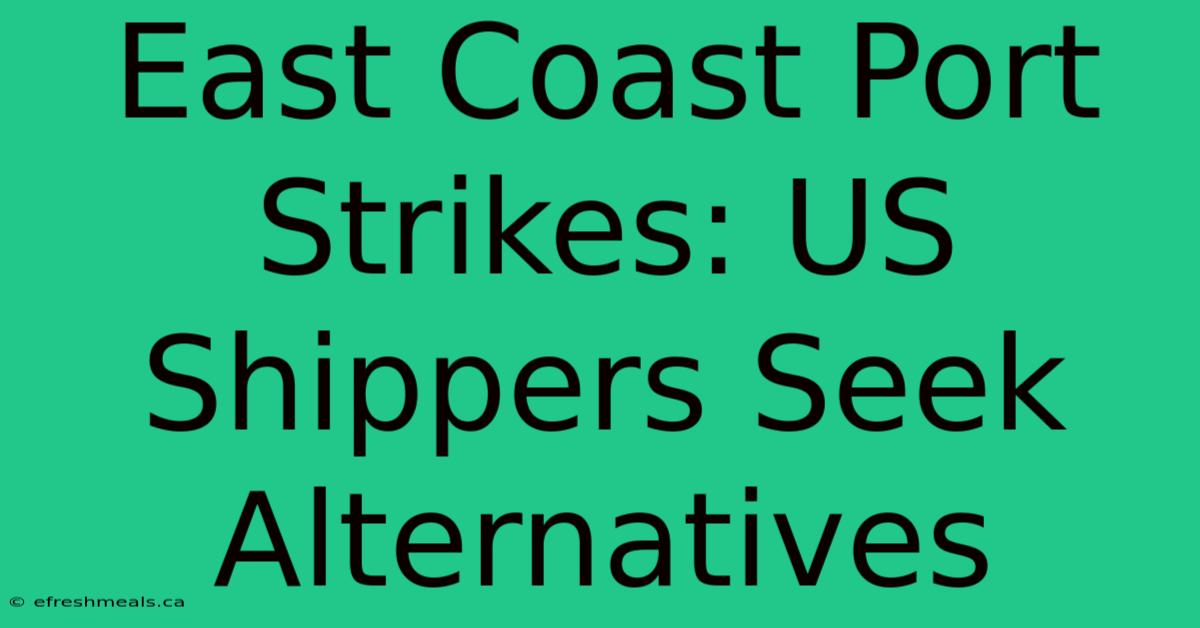East Coast Port Strikes: US Shippers Seek Alternatives

Discover more detailed and exciting information on our website. Click the link below to start your adventure: Visit Best Website nimila.me. Don't miss out!
Table of Contents
East Coast Port Strikes: US Shippers Seek Alternatives
Editor's Note: The recent port strikes on the US East Coast have caused widespread disruption to supply chains, forcing shippers to scramble for alternative routes and solutions.
Why It Matters: The East Coast ports are vital to the US economy, handling billions of dollars worth of goods every year. These strikes have had a significant impact on businesses of all sizes, leading to delays, higher costs, and a general sense of uncertainty.
Key Takeaways of Port Strikes:
| Impact | Details | Consequences |
|---|---|---|
| Delays | Cargo stuck at docks, vessels unable to unload or load. | Increased shipping time, missed deadlines, potential stock shortages. |
| Higher Costs | Increased storage fees, additional transportation costs. | Reduced profit margins, potential price increases for consumers. |
| Supply Chain Disruptions | Uncertainty for businesses, difficulty in planning and forecasting. | Reduced efficiency, decreased productivity, potential loss of revenue. |
The Impact of East Coast Port Strikes:
The recent strikes have highlighted the vulnerability of the US supply chain and the importance of finding more resilient solutions. Shippers are exploring various options, including:
Alternative Ports:
- Gulf Coast Ports: Ports in Texas and Louisiana are becoming increasingly popular as alternatives, offering potential for reduced congestion and faster turnaround times.
- West Coast Ports: While longer transit times are a concern, some shippers are opting for West Coast ports due to a perceived lower risk of labor disruptions.
- Canadian Ports: Ports in Halifax and Montreal offer a potential solution, particularly for businesses operating in Eastern Canada.
Intermodal Transportation:
- Rail: The increased use of rail transport is becoming a more attractive option, offering a reliable and cost-effective way to move goods across the country.
- Truck: While truck transport is less efficient over long distances, it offers flexibility for shorter hauls and can complement other transportation modes.
Shifting Logistics:
- Nearshoring: Businesses are considering relocating manufacturing or warehousing facilities closer to their customers, reducing reliance on long-distance shipping.
- Reshoring: Some companies are bringing production back to the US, potentially mitigating supply chain risks and boosting domestic jobs.
The Role of Technology:
- Real-Time Data: Advanced tracking systems and data analytics provide valuable insights into supply chain performance, enabling better decision-making and proactive risk management.
- Artificial Intelligence (AI): AI-powered tools can optimize shipping routes, predict delays, and automate tasks, increasing efficiency and reducing costs.
The Future of Port Strikes:
While the recent strikes have brought significant challenges, they have also provided a catalyst for innovation and improvement. As the shipping industry adapts to these disruptions, we can expect to see:
- Increased Investment: Greater investments in infrastructure, technology, and alternative transportation modes.
- Improved Labor Relations: Stronger partnerships between labor and management to address concerns and improve working conditions.
- Diversification of Supply Chains: A shift towards more resilient and diverse supply chains, reducing reliance on any single port or region.
FAQ for East Coast Port Strikes:
| Question | Answer |
|---|---|
| How long will the strikes last? | The duration of the strikes is uncertain, but it is expected to be resolved eventually through negotiation or government intervention. |
| What are the main demands of the dockworkers? | Dockworkers are seeking higher wages, improved benefits, and more job security. |
| How will the strikes impact consumers? | Consumers may face higher prices, product shortages, or delays in receiving their orders. |
| Are there any alternatives to using East Coast ports? | Yes, shippers can consider using alternative ports, intermodal transportation, or relocating their facilities. |
| What steps can businesses take to mitigate the impact of the strikes? | Businesses should monitor the situation, diversify their supply chains, and consider alternative transportation options. |
| What is the long-term impact of the strikes on the US economy? | The strikes have highlighted the need for a more resilient supply chain, which may lead to increased investment in infrastructure and technology. |
Tips for Navigating East Coast Port Strikes:
- Monitor the situation closely: Stay updated on the latest developments and potential disruptions.
- Diversify your supply chain: Reduce reliance on any single port or region.
- Explore alternative transportation options: Consider rail, truck, or air transport.
- Communicate with your suppliers and customers: Keep them informed about potential delays or disruptions.
- Be prepared for increased costs: Anticipate higher shipping and storage fees.
Summary of East Coast Port Strikes:
The recent port strikes on the US East Coast have significantly disrupted supply chains, forcing shippers to seek alternative solutions and raising concerns about the resilience of the US economy. By diversifying their supply chains, exploring new transportation options, and embracing technological advancements, businesses can navigate these challenges and create a more resilient future for the shipping industry.
Closing Message: These disruptions offer an opportunity for the US shipping industry to rethink its strategies and prioritize long-term sustainability and resilience. As we move forward, a focus on collaboration, innovation, and investment will be crucial to securing a smoother and more efficient flow of goods for the future.

Thank you for visiting our website wich cover about East Coast Port Strikes: US Shippers Seek Alternatives. We hope the information provided has been useful to you. Feel free to contact us if you have any questions or need further assistance. See you next time and dont miss to bookmark.
Featured Posts
-
Sparkling Deepavali Wishes From Hro
Nov 01, 2024
-
Tornado Warning Delaware Ottawa Counties
Nov 01, 2024
-
French Motorways Red Lines Explained
Nov 01, 2024
-
Fatal Accident Wheel Strikes Suv On Highway 401
Nov 01, 2024
-
Nba Pacers Top Celtics Both Teams Undefeated
Nov 01, 2024
